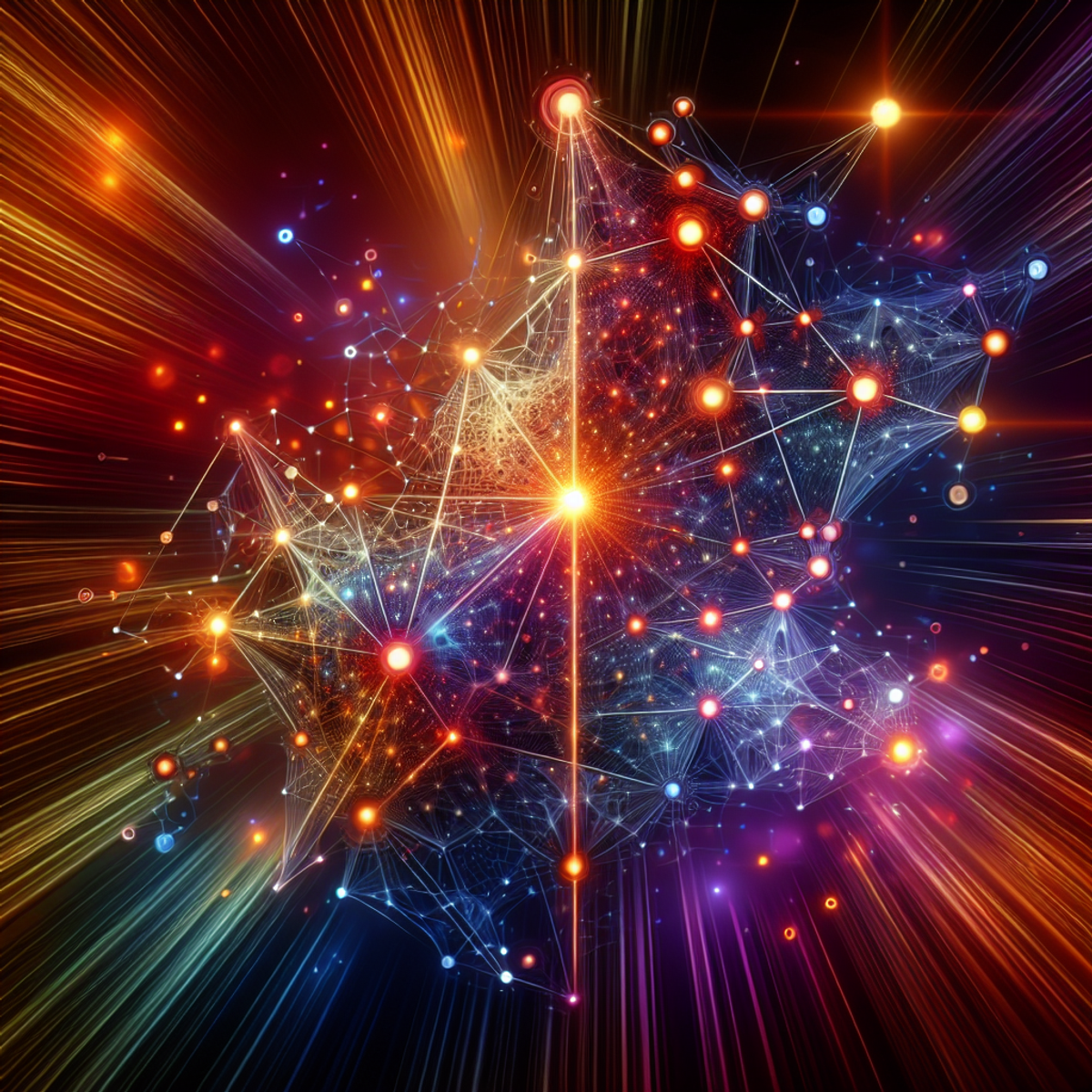Python for Network Automation: Getting Started
Python for Network Automation: Getting Started
Introduction to Python for Network Automation

Python for network automation is a powerful tool that has revolutionized the field of networking. It is a programming language that allows network engineers to automate repetitive tasks, streamline operations, and improve overall efficiency in network management and configuration.
Benefits of Using Python for Network Automation
Using Python for network automation offers several key benefits and advantages:
- Increased Efficiency: Python allows network engineers to automate time-consuming tasks, such as provisioning and configuring network devices. This significantly reduces manual effort and speeds up the overall process.
- Scalability: With Python, it becomes easier to scale network automation tasks across multiple devices or even entire networks. This scalability ensures consistency and reliability in network operations.
- Reduced Manual Errors: Automating network operations with Python minimizes the risk of human errors that can occur during manual configuration. This leads to improved stability and reliability in network environments.
One real-life example of Python's effectiveness in network automation is the use of Netmiko, a multi-vendor library that simplifies interactions with network devices. By using Netmiko, network engineers can quickly establish connections with various types of devices, execute commands remotely, and retrieve device configurations seamlessly.
Real-Life Example: Configuration Backups
In a large-scale deployment scenario, a company successfully utilized Python for automating configuration backups across hundreds of routers and switches. With just a few lines of code, they were able to schedule regular backups, store them securely, and ensure fast disaster recovery when needed.
Python for network automation has become an essential skillset for modern network engineers. It empowers them to manage complex networks efficiently and focus on strategic initiatives rather than mundane tasks.
In the following sections, we will explore the prerequisites for learning Python for network automation and guide you through setting up your development environment.
Why Python?
Python is one of the most popular programming languages in the field of network automation. Its simplicity, versatility, and extensive library support make it a preferred choice for network engineers. Here are some key reasons why Python is widely used in network automation:
1. Ease of Use: Python has a clean and readable syntax, making it easy to learn and understand even for beginners. Its simplicity allows network engineers to quickly write scripts and automate repetitive tasks.
2. Wide Range of Libraries: Python boasts a vast collection of libraries and frameworks specifically designed for networking tasks. These libraries provide pre-built functions and modules that simplify complex operations like device configuration, monitoring, and troubleshooting.
3. Vendor-agnostic Approach: Python is vendor-agnostic, meaning it can be used with various networking devices from different manufacturers. It offers libraries like Netmiko, NAPALM, and Paramiko that support multi-vendor network automation, reducing the need for vendor-specific scripting languages.
4. Scalability: Python's scalability enables network engineers to automate tasks across large-scale networks efficiently. With its ability to handle parallel processing, Python can perform multiple operations simultaneously, saving time and increasing productivity.
5. Integration with other Tools: Python seamlessly integrates with other tools commonly used in network automation workflows. It can be combined with tools like Ansible, Nornir, or SaltStack to create powerful automation frameworks that streamline network management processes.
6. Active Community Support: Python has a vibrant community of developers who actively contribute to its growth. The availability of online resources, forums, and tutorials makes it easier for network engineers to learn and seek help when facing challenges.
In summary, Python's ease of use, extensive library support, vendor-agnostic approach, scalability, integration capabilities, and active community support make it an ideal choice for network automation tasks. By leveraging Python's power and flexibility, network engineers can streamline their operations, increase efficiency, and reduce manual errors in their daily tasks.
Prerequisites for Learning Python for Network Automation
Before you start learning Python for network automation, it's important to have some key skills and knowledge areas as a network engineer. These prerequisites will help you better understand and apply Python in the context of network automation. Here are the important prerequisites to consider:
- Solid understanding of networking protocols and concepts: Having a strong foundation in networking protocols, such as TCP/IP, ICMP, SNMP, OSPF, and BGP, is crucial. Understanding concepts like VLANs, subnets, routing tables, and network topologies will also be beneficial.
- Experience working with network devices: It's essential to have hands-on experience with network devices such as routers and switches. Familiarity with their configurations, command-line interfaces (CLIs), and management protocols (e.g., SSH, Telnet) will enable you to interact with these devices programmatically using Python.
- Basics of command-line interface (CLI) operations: Knowledge of CLI operations on network equipment is advantageous. Being comfortable with executing commands, configuring devices, and retrieving information through the CLI will help you leverage Python to automate these tasks effectively.
Having these prerequisites in place will prepare you well for learning Python for network automation. These foundational skills and knowledge areas will provide a solid framework for understanding how Python can be applied in a networking environment.
Remember that learning Python is an ongoing process, and as you progress in your automation journey, you'll continue to enhance your skills and knowledge. Embrace this learning experience as an opportunity to grow your expertise in both networking and programming.
Setting up the Development Environment
To get started with Python for network automation, you'll need to set up your development environment. This involves installing the necessary software tools and configuring them for optimal performance. In this section, we will cover the steps to set up GNS3 and briefly introduce Netmiko, which will be covered in detail later.
Overview of Software Tools
The two main software tools we will be using in this tutorial are GNS3 and Netmiko.
- GNS3: GNS3 is a powerful network simulation tool that allows you to create virtual networks using real Cisco images. It provides a realistic environment for testing and troubleshooting network configurations without the need for physical hardware. GNS3 supports a wide range of network devices, including routers, switches, and firewalls.
- Netmiko: Netmiko is a Python library that simplifies network device interactions. It provides a unified API (Application Programming Interface) for connecting to various network devices using SSH or Telnet protocols. With Netmiko, you can automate tasks such as retrieving device configurations, executing commands, and parsing output.
Setting up GNS3
Now let's dive into setting up GNS3 on your local machine:
- Download: Go to the official GNS3 website (https://www.gns3.com/) and download the latest version of GNS3 for your operating system (Windows, macOS, or Linux).
- Installation: Once the download is complete, run the installer and follow the on-screen instructions to install GNS3 on your machine.
- Preferences: After installation, launch GNS3 and navigate to the Preferences menu. Here, you can configure various settings to optimize your experience with GNS3. Some important preferences to consider include:
- Server Settings: Configure server settings based on your machine's specifications.
- IOS Images: Import IOS images to use in your network simulations.
- Virtualization: Choose the virtualization software you want to use (e.g., VMware, VirtualBox) for running network device images.
By following these steps, you will have successfully set up GNS3 on your local machine. In the next section, we will focus on installing Python 3 and the required libraries for network automation.
2. Installing Python3 and the Required Libraries
Why Python 3 is Recommended for Network Automation
Python version 3 is highly recommended for network automation due to its enhanced features, improved performance, and ongoing support from the developer community. With its clean and easy-to-understand syntax, Python 3 offers a robust foundation for building efficient network automation scripts.
Installing Python 3.x and pip
To begin your journey into Python network automation, you need to install Python 3.x on your local machine. The installation process varies depending on your operating system, but it generally involves downloading the Python installer from the official website and running it to set up Python on your system. Additionally, the installation includes setting up pip, which is the package manager for Python. Pip simplifies the process of installing and managing libraries that extend the functionality of Python.
Understanding Netmiko Library
Netmiko is a powerful library that simplifies the process of interacting with network devices using Python scripts. It provides a consistent and straightforward way to automate interactions with a wide range of network devices through SSH and Telnet connections. Netmiko abstracts the complexities of handling different device types and communication protocols, allowing network engineers to focus on writing concise and effective automation scripts.
Installing Netmiko using pip
Once Python 3.x is installed on your system, you can proceed to install Netmiko using pip. The installation command is simple and straightforward:
bash pip install netmiko
Executing this command in your terminal or command prompt will automatically download and install the Netmiko library along with any dependencies it requires. Once installed, Netmiko can be imported into your Python scripts, enabling seamless automation of network device interactions.
By understanding these fundamental steps for installing Python 3.x and integrating the Netmiko library into your development environment, you are well-equipped to delve into creating impactful network automation solutions using Python.
3. Establishing Connectivity between GNS3 and Netmiko

Connecting GNS3 with Netmiko requires the utilization of a loopback adapter. This concept is crucial for setting up the network automation environment and enabling communication between GNS3 and Netmiko scripts. Here's a step-by-step guide to establishing connectivity:
Understanding the concept of a loopback adapter
A loopback adapter is a virtual network interface that allows communication between different software components running on your machine. In the context of network automation with GNS3 and Netmiko, the loopback adapter acts as a bridge between GNS3 and your Python scripts.
Creating and configuring a loopback adapter
To create a loopback adapter on your machine, follow these steps:
- Open the Network Connections settings on your operating system.
- Click on "Create a new connection" or "Add new network" option.
- Select "Loopback" or "Loopback Adapter" from the available options.
- Configure the loopback adapter with an IP address (e.g., 192.168.1.1) and subnet mask (e.g., 255.255.255.0).
- Save the configuration and close the Network Connections settings.
Associating the loopback adapter with a virtual router in GNS3
After creating the loopback adapter, you need to associate it with a virtual router in GNS3 to establish communication with Netmiko scripts. Follow these steps:
- Open GNS3 on your local machine.
- Drag and drop a router device onto the workspace.
- Right-click on the router and select "Configure".
- In the router configuration window, go to the "Interfaces" section.
- Add a new interface and select the previously created loopback adapter as its source.
- Save the configuration changes.
By completing these steps, you have successfully established connectivity between GNS3 and Netmiko. The loopback adapter serves as the bridge between GNS3's virtual network and your Python scripts, enabling you to interact with network devices programmatically.
The loopback adapter provides a reliable and consistent interface for communication, regardless of the underlying physical network configurations. It allows you to simulate network devices within GNS3 and control them using Netmiko scripts.
With connectivity established, you can now proceed to the next section and start writing and executing Python scripts for network automation using Netmiko.
4. Writing and Executing Python Scripts for Network Automation with Netmiko
Now that you have established connectivity between GNS3 and Netmiko, it's time to dive into writing Python scripts for network automation using Netmiko's powerful functions and methods. This section will guide you through the process of writing your first Python script, incorporating advanced features, and performing basic parsing or filtering operations on configuration data.
Writing your first Python script
To get started with network automation using Netmiko, you need to establish a Telnet or SSH connection to a network device. Netmiko provides a variety of functions and methods to simplify this process. Here are the steps to write your first Python script:
- Import the necessary modules:
python from netmiko import ConnectHandler
- Define the device details such as IP address, username, password, and device type:
python device = { 'device_type': 'cisco_ios', 'ip': '192.168.0.1', 'username': 'admin', 'password': 'password' }
- Establish a connection to the device:
python connection = ConnectHandler(**device)
- Execute commands on the device:
python output = connection.send_command('show interfaces') print(output)
By following these steps, you can establish a connection to a network device and retrieve information from it using Netmiko's send_command function.
Incorporating advanced features into your scripts
To ensure your scripts are robust in real-world scenarios, it's important to incorporate advanced features such as error handling and logging. Here are some tips:
- Error handling: Use try-except blocks to handle exceptions that may occur during the execution of your script. This will help you gracefully handle errors and prevent your script from crashing.
- Logging: Use Python's logging module to log important events and messages in your script. This will help you troubleshoot issues and track the execution of your script.
Example code snippet for retrieving configuration data
To give you a practical example, let's retrieve the running configuration of a network device using Netmiko:
python running_config = connection.send_command('show running-config') print(running_config)
This code snippet uses Netmiko's send_command function to execute the show running-config command on the device and retrieves the output.
Analyzing and filtering configuration data
Once you have obtained the configuration data, you can perform basic parsing or filtering operations to extract specific information. For example, you can use Python's string manipulation functions or regular expressions to search for specific keywords or patterns in the configuration data.
python interfaces = [] for line in running_config.splitlines(): if line.startswith('interface'): interfaces.append(line.split()[1])
print(interfaces)
In this code snippet, we iterate over each line of the configuration data and extract the interface names by checking if the line starts with 'interface'. The extracted interface names are then stored in a list.
By leveraging these techniques, you can write powerful Python scripts for network automation using Netmiko. Experiment with different commands and operations to automate various network tasks efficiently.
Next Steps in Your Python for Network Automation Journey
Now that you have taken your first steps into the world of Python for network automation, it's time to explore further resources and tools to enhance your skills and knowledge in this domain. Here are a few suggested next steps to continue your learning journey:
Suggested Resources
- Python for Network Automation by Jason Edelman, Scott S. Lowe, and Matt Oswalt provides comprehensive insights into leveraging Python for network automation tasks, making it an invaluable resource for beginners and experienced professionals alike.
- Automate the Boring Stuff with Python by Al Sweigart offers a practical approach to learning Python through real-world examples, which can be applied to network automation scenarios as well.
- Online platforms like Coursera and Udemy offer specialized courses on Python for network automation, providing a structured learning path with hands-on projects and expert guidance.
Exploring Other Libraries and Frameworks
- NAPALM (Network Automation and Programmability Abstraction Layer with Multivendor support) is a powerful library that simplifies the interaction with network devices from various vendors, offering a consistent interface for configuration management and operational tasks.
- Ansible, though not a Python library per se, is a popular open-source automation tool that can be integrated with Python scripts for network configuration management, orchestration, and deployment.
By delving into these resources and exploring additional libraries and frameworks, you can expand your proficiency in Python for network automation while uncovering new possibilities for streamlining network operations.
Understanding Basic Network Concepts
Before we start using Python for network automation, it's important to have a clear understanding of basic network concepts. This will help you grasp the following sections better and use Python effectively in your network automation tasks.
1. Networking Protocols
Networking protocols are a set of rules that govern how devices communicate in a network. They're crucial for network automation, so let's quickly go over some important ones:
- TCP/IP: The fundamental protocol suite used for communication over the internet and most computer networks. It consists of two main protocols: TCP, which ensures reliable data delivery, and IP, which handles addressing and routing.
- SSH: A secure network protocol that allows remote access to devices over an unsecured network. It enables secure command-line operations and file transfers between devices.
- Telnet: An unencrypted protocol used for remote terminal connections. While it lacks security features like SSH, it is still used for certain tasks in non-sensitive environments.
2. Network Devices
Network devices are components (either hardware or software) that enable communication within a network. As a network engineer, it's important to be familiar with common network devices and what they do:
- Routers: Responsible for routing data packets between different networks based on IP addresses.
- Switches: Connect multiple devices within a local area network (LAN) using MAC addresses.
- Firewalls: Act as barriers between networks, controlling incoming and outgoing traffic based on security policies.
- Load Balancers: Distribute incoming network traffic across multiple servers to ensure efficient resource utilization.
3. Command-Line Interface (CLI) Operations
Command-Line Interface (CLI) is a text-based interface used to interact with network devices. As a network engineer, you should be comfortable with basic CLI operations for device configuration and management:
- Accessing Devices: Connecting to devices via SSH or Telnet to access the command-line interface.
- Configuration: Setting up network devices by entering commands to configure various settings.
- Monitoring: Checking real-time data from devices using commands to view status and tables.
- Troubleshooting: Diagnosing and resolving network issues using CLI commands.
Understanding these basic network concepts will provide a strong foundation for using Python in network automation tasks. Python scripts can:
- Interact with network devices through protocols like SSH and Telnet.
- Gather information from devices using CLI commands.
- Configure devices remotely.
- Automate repetitive tasks.
In the next section, we will learn how to set up your development environment for Python network automation using tools like GNS3 and Netmiko.
Writing Your First Script
Once you have set up your development environment and gained a basic understanding of network concepts, it's time to dive into writing your first Python script for network automation. This section will guide you through the process of creating a simple script using the Netmiko library to establish a connection to a network device and retrieve its running configuration.
Importing the Required Modules
Before you start writing the script, it's essential to import the necessary modules and libraries into your Python environment. In this case, you'll need to import the Netmiko library, which provides easy-to-use functions for interacting with network devices.
python from netmiko import ConnectHandler
Establishing a Connection
To establish a connection to a network device using Netmiko, you'll need to define the device's parameters such as its IP address, SSH or Telnet port, username, password, and device type. Once these parameters are defined, you can create a connection object using the ConnectHandler class provided by Netmiko.
python
Define the device parameters
device = { 'device_type': 'cisco_ios', 'host': '192.168.1.1', 'username': 'admin', 'password': 'password123', 'port': 22, # Change to 23 for Telnet }
Create an SSH connection object
connection = ConnectHandler(**device)
Retrieving Device Information
After successfully establishing a connection, you can utilize Netmiko's methods to interact with the network device. For example, you can retrieve the running configuration of the device using the send_command method.
python
Send a command to retrieve running configuration
output = connection.send_command('show running-config') print(output)
Closing the Connection
It's important to close the connection once you have finished interacting with the device to release any allocated resources and maintain good practice.
python
Close the SSH connection
connection.disconnect()
Script Analysis
Let's break down what each part of this script accomplishes:
- Importing Modules: The
from netmiko import ConnectHandlerstatement imports the necessary module for connecting to network devices. - Establishing a Connection: The
devicedictionary stores the parameters required for connecting to the network device. These parameters are then passed toConnectHandlerto create an SSH connection. - Retrieving Device Information: The
send_commandmethod is used to send a command (in this case, "show running-config") to the connected device and store its output in theoutputvariable. - Closing the Connection: The
disconnectmethod is called on the connection object to gracefully close the SSH session.
By understanding and experimenting with this basic script, you're taking your first step towards automating network tasks using Python. As you become more comfortable with these fundamental concepts, you can gradually explore more complex automation scenarios and leverage additional features offered by Netmiko and other Python libraries tailored for network automation.
Learning Resources
When it comes to learning Python for network automation, there are plenty of resources available to help you get started and improve your skills. Whether you prefer books, online courses, or interactive tutorials, these learning resources will provide you with the knowledge and practice you need to become proficient in Python for network automation. Here are some highly recommended resources:
Books
- "Automate the Boring Stuff with Python" by Al Sweigart: This book is a great introduction to Python programming, covering the basics as well as more advanced topics. It includes practical examples and projects that can be applied to network automation tasks.
- "Python Network Programming for Network Engineers" by Eric Chou: This book specifically targets network engineers and provides a comprehensive guide to using Python for networking tasks. It covers topics such as network protocols, socket programming, and automation scripts.
- "Python Programming for Cisco Networking Engineers" by Harris Andrea: If you work with Cisco networking equipment, this book is a valuable resource. It focuses on using Python for Cisco device configuration and management, providing hands-on examples and real-world scenarios.
Online Courses
- Cisco DevNet: Network Programmability Basics (free): This online course offered by Cisco gives you a solid foundation in network programmability using Python. It covers topics such as APIs, data models, and software development practices in the context of networking.
- Network Programmability and Automation on Udemy: This course provides a comprehensive introduction to network programmability and automation using Python. It covers topics such as REST APIs, NETCONF, YANG data models, and automating network configurations.
Interactive Tutorials
- Codecademy (Python track): Codecademy offers an interactive platform where you can learn Python at your own pace. The Python track covers all the fundamentals of the language and includes hands-on exercises that can be applied to network automation.
- Real Python: Real Python is an online platform that offers a wide range of Python tutorials and articles. They have specific tutorials on networking and automation topics, including using libraries like Netmiko and NAPALM.
Forums and Communities
- Python for Network Automation (pynet.twb-tech.com): This online community is dedicated to Python for network automation. It provides forums where you can ask questions, share ideas, and learn from others in the field.
- r/networking (Reddit): The networking subreddit is a great place to connect with other network engineers and Python enthusiasts. It has a dedicated community of professionals who are willing to help and share their experiences in network automation.
Remember, the key to learning Python for network automation is practice. Along with these resources, make sure to spend time experimenting with your own scripts and challenges. By applying what you learn in real-world scenarios, you'll gain practical experience and deepen your understanding of Python's capabilities for network automation.
Practice and Experiment
Now that you have learned the basics of Python for network automation, it's time to put your knowledge into practice and start experimenting with different scenarios. By practicing and experimenting, you will gain hands-on experience and become more comfortable with using Python to automate network tasks. Here are some tips and suggestions to help you get started:
- Start with simple scripts: Begin by writing simple scripts that perform basic tasks, such as establishing a connection to a network device or retrieving device information. This will help you understand the fundamentals of using Python for network automation.
- Build on existing examples: There are numerous resources available online that provide example scripts for various network automation tasks. Use these examples as a starting point and modify them to fit your specific requirements. This will help you learn different techniques and approaches to solving common networking challenges.
- Experiment with different libraries: In addition to Netmiko, there are several other libraries and frameworks available for network automation in Python. Take the time to explore libraries like NAPALM, Paramiko, and Ansible. Each library has its own strengths and may be better suited for certain types of tasks.
- Create a lab environment: Setting up a lab environment using tools like GNS3 or Cisco VIRL can provide you with a safe space to practice and experiment without impacting production networks. This allows you to test your scripts and configurations in a controlled environment before deploying them in a live network.
- Debug and troubleshoot: As with any programming language, it's important to develop good debugging skills. When your scripts don't produce the expected results, use debugging techniques such as print statements or logging to identify issues in your code. Additionally, familiarize yourself with error messages and learn how to troubleshoot common errors.
- Explore APIs: Many network devices now offer APIs that allow programmatic access to their functionalities. Take advantage of these APIs to integrate your Python scripts with network devices and extract valuable data. APIs can provide a more efficient and scalable approach to network automation.
- Participate in online communities: Engaging with the network automation community can be a great way to learn from others and get feedback on your scripts. Join online forums, participate in discussions, and contribute to open-source projects related to network automation. This will help you expand your knowledge and stay up-to-date with the latest developments in the field.
Remember, practice makes perfect! The more you practice and experiment with Python for network automation, the more confident and proficient you will become. Don't be afraid to make mistakes and learn from them. Over time, you will be able to automate complex network tasks efficiently and effectively using Python.
Keep exploring and expanding your skills, as there is always more to learn in the world of Python for network automation!
Conclusion
Python has become a powerful tool for network automation and is quickly becoming an essential skill for network engineers. With its simplicity, versatility, and extensive libraries, Python offers many advantages for automating network tasks.
- Python's benefits for network automation include increased efficiency, scalability, and reduced manual errors. By using Python's scripting capabilities, network engineers can automate repetitive tasks, streamline workflows, and save time and resources.
- In addition to its technical advantages, Python also has a strong community and a wide range of libraries and frameworks specifically designed for network automation. By embracing Python, network engineers can access a wealth of resources and collaborate with like-minded professionals.
To get started with Python for network automation:
- Acquire the necessary skills: Before diving into Python for automation, it is important to have a solid understanding of networking protocols and concepts. Additionally, experience working with network devices such as routers and switches and familiarity with command-line interface (CLI) operations on network equipment will be beneficial.
- Set up your development environment: Install GNS3 for network simulation purposes and configure it according to your preferences. Additionally, install Python 3.x along with the required libraries such as Netmiko.
- Establish connectivity between GNS3 and Netmiko: Create and configure a loopback adapter on your machine and associate it with a virtual router in GNS3 to enable communication with Netmiko scripts.
- Write and execute Python scripts for network automation: Start by writing simple scripts to establish Telnet or SSH connections to network devices using Netmiko's functions and methods. Gradually incorporate advanced features such as error handling and logging to ensure robustness in real-world scenarios.
By following these steps, you can begin applying Python for automation purposes in your own network environment. Remember that this article serves as just the starting point of your Python journey for network automation. There are plenty of additional resources, books, and online courses available to further enhance your Python skills and knowledge in the context of network automation.
Embrace the power of Python for network automation and unlock new possibilities in network management and efficiency. Start exploring the concepts and techniques covered in this article and take your network automation skills to the next level.
FAQs (Frequently Asked Questions)
What is Python for network automation and how is it used in the field of networking?
Python for Network Automation provides a brief explanation of what Python is used for in the context of network automation. It highlights the key benefits and advantages of using Python for network automation tasks, such as increased efficiency, scalability, and reduced manual errors. Additionally, it engages the readers by showcasing a real-life example or success story where Python was utilized for network automation with impressive results.
What are the prerequisites for learning Python for Network Automation?
This section outlines important skills and knowledge areas that network engineers should have before diving into Python for automation. It includes a solid understanding of networking protocols and concepts, experience working with network devices such as routers and switches, and basics of command-line interface (CLI) operations on network equipment.
How do I set up the development environment for Python for Network Automation?
This part provides an overview of the software tools that will be used in the tutorial, including GNS3 (briefly mentioned) and Netmiko (to be covered in detail later). It also offers a step-by-step guide on setting up GNS3 on your local machine for network simulation purposes, including downloading and installing GNS3, as well as configuring GNS3 preferences for optimal performance.
How do I install Python3 and the required libraries for Network Automation?
This section gives a brief introduction to Python version 3 and why it is recommended for network automation. It then provides instructions for installing Python 3.x along with pip, the package manager for Python. Additionally, it explains in-depth about the Netmiko library and demonstrates the installation process using pip.
How can I establish connectivity between GNS3 and Netmiko?
This part explains the concept of a loopback adapter and why it is utilized in the network automation setup with GNS3 and Netmiko. It also provides step-by-step instructions for creating and configuring a loopback adapter on your machine, along with associating the loopback adapter with a virtual router in GNS3 to enable communication with Netmiko scripts.
How can I write and execute Python scripts for Network Automation with Netmiko?
In this section, you will learn how to write your first Python script to establish a Telnet or SSH connection to a network device using Netmiko's functions and methods. It also covers incorporating advanced features into your scripts, such as error handling and logging, to ensure robustness in real-world scenarios. Additionally, an example code snippet for retrieving the running configuration of a network device through Netmiko is provided, along with basic parsing or filtering operations.
What are the next steps in my Python for Network Automation journey?
This section suggests resources (books, online courses, etc.) to further enhance your Python skills and knowledge in the context of network automation. It also encourages you to explore other popular libraries and frameworks for network automation tasks, such as NAPALM and Ansible.


Comments
Post a Comment